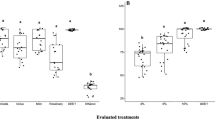Abstract
The mosquito feeding and ovipositional repellency of the major monoterpenoid present in the volatile oil ofHemizonia fitchii (Asteraceae), i.e., 1,8-cineole, was investigated. Although 1,8-cineole did not exhibit any significant mosquito larvicidal activity, it was moderately effective as a feeding repellent and highly effective as an ovipositional repellent against adultAedes aegypti (yellow fever mosquito). The ovipositional repellency of 1,8-cineole, coupled with the presence of severalHemizonia chromenes previously shown to possess mosquito larvicidal activity, may therefore account in large part for the observed suppression of local mosquito populations which was associated withH. fitchii plants in northern California.
Similar content being viewed by others
References
Apha Project Staff. 1979. Handbook of Nonprescription Drugs, 6th ed. American Pharmaceutical Association, Washington, D.C., pp. 88, 90, 261, 322, 330, 355, 359–360.
Bianchini, F., Corbetta, F., andPistoia, M. 1985. The Complete Book of Health Plants. Crescent Books, New York, pp. 100–101, 205.
Cribb, A.B., andCribb, J.W. 1983. Wild Medicine in Australia. Fontana/Collins, Sydney, pp. 71–75.
Der Marderosian, A.H. 1975. Pesticides, pp. 1182–1207,in A. Osol and J.E. Hoover (eds.). Remington's Pharmaceutical Sciences, 15th ed. Mack Publishing, Easton, Pennsylvania.
Dethier, V.G. 1956. Repellents.Annu. Rev. Entomol. 1:181–202.
Duke, J.A. 1985. CRC Handbook of Medicinal Herbs. CRC Press, Boca Raton, Florida, pp. 69–70, 185–186, 271–273, 301–302, 412–413, 420–422.
Grieve, M. 1971. A Modern Herbal. Dover Publications, New York (reprint of the original 1931 ed.), Vol. I, pp. 151–152, 287–289; Vol. II, pp. 464–465, 467–473.
Harborne, J.B. 1982. Introduction to Ecological Biochemistry, 2nd ed. Academic Press, New York, pp. 50–57, 212–217.
Jacobson, M. 1966. Chemical insect attractants and repellents.Annu. Rev. Entomol. 11:403–422.
Janzen, D.H., DeVries, P.J., Higgins, M.L., andKimsey, L.S. 1982. Seasonal and site variation in Costa Rican euglossine bees at chemical baits in lowland deciduous and evergreen forests.Ecology 63:66–74.
Klocke, J.A., andBalandrin, M.F. 1984. Isolation of insecticidal linear furanocoumarins fromThamnosma montana (Rutaceae). Proceedings of the 25th Annual Meeting of the American Society of Pharmacognosy, Abstr. No. 32, University of Texas at Austin, Texas.
Klocke, J.A., Balandrin, M.F., Adams, R.P., andKingsford, E. 1985. Insecticidal chromenes from the volatile oil ofHemizonia fitchii.J. Chem Ecol. 11:701–712.
Klocke, J.A., Van Wagenen, B., andBalandrin, M.F. 1986. The ellagitannin geraniin and its hydrolysis products isolated as insect growth inhibitors from semiarid land plants.Phytochemistry 25:85–91.
Leung, A.Y. 1980. Encyclopedia of Common Natural Ingredients Used in Food, Drugs, and Cosmetics. Wiley-Interscience, New York, pp. 54–56, 82–83, 166–167, 214–217, 283–285.
Lust, J.B. 1974. The Herb Book. Bantam Books, New York, p. 566.
Maugh, T.H., II. 1982. To attract or repel, that is the question.Science 218:278.
Moore, B.P., andBrown, W.V., 1981. Identification of warning odour components, bitter principles and antifeedants in an aposematic beetle:Metriorrhynchus rhipidius (Coleoptera: Lycidae).Insect Biochem. 11:493–499.
Morton, J.F. 1976. Herbs and Spices. Golden Press, New York, pp. 43, 147.
Myers, N. 1984. Wild genetic resources.Impact Sci. Soc. (UNESCO) 34:327–333.
Olagbemiro, T.O., andStaddon, B.W. 1983. Isoprenoids from metathoracic scent gland of cotton seed bug,Oxycarenus hyalinipennis (Costa) (Heteroptera: Lygaeidae).J. Chem. Ecol. 9:1397–1412.
Proksch, P., andRodriguez, E. 1983. Chromenes and benzofurans of the Asteraceae, their chemistry and biological significance.Phytochemistry 22:2335–2348.
Rodriguez, E. 1983. Cytotoxic and insecticidal chemicals of desert plants, pp. 291–302,in P.A. Hedin (ed.). Plant Resistance to Insects. ACS Symposium Series No. 208. American Chemical Society, Washington, D.C.
Rodriguez, E., andLevin, D.A. 1976. Biochemical parallelisms of repellents and attractants in higher plants and arthropods.Recent Adv. Phytochem. 10:214–270.
Romero, G. A., andNelson, C.E. 1986. Sexual dimorphism inCatasetum orchids: Forcible pollen emplacement and male flower competition.Science 232:1538–1540.
Saxena, K.N., andBasit, A. 1982. Inhibition of oviposition by volatiles of certain plants and chemicals in the leafhopperAmrasca devastans (Distant).J. Chem. Ecol. 8:329–338.
Saxena, K.N., andKumar, H. 1984. Interference of sonic communication and mating in leafhopperAmrasca devastans (Distant) by certain volatiles.J. Chem. Ecol. 10:1521–1531.
Schearer, W.R. 1984. Components of oil of tansy (Tanacetum vulgare) that repel Colorado potato beetles (Leptinotarsa decemlineata).J. Nat. Prod. 47:964–969.
Scriven, R., andMeloan, C.E. 1984. Determining the active component in 1,3,3-trimethyl-2-oxabicyclo[2,2,2]octane (cineole) that repels the American cockroach,Periplaneta americana.Ohio J. Sci. 84(3):85–88.
Smith, R.C. 1962. The mosquito as a laboratory animal.Am. Biol. Teacher 24(7):513–516.
Stuart, M. (ed.). 1982. Herbs and Herbalism. Van Nostrand Reinhold Co., New York, pp. 59, 83, 92–93, 126.
Swinyard, E.A., andLowenthal, W. 1975. Pharmaceutical necessities, pp. 1221–1269,in A. Osol and J.E. Hoover (eds.). Remington's Pharmaceutical Sciences, 15th ed. Mack Publishing, Easton, Pennsylvania.
Tyler, V.E., Brady, L.R., andRobbers, J.E. 1981. Pharmacognosy, 8th ed. Lea & Febiger, Philadelphia, pp. 138–141.
Verma, M., andMeloan, C.E. 1981. A natural cockroach repellent in bay leaves.Am. Lab. 13(10):64–69.
von Rudloff, E. 1969. Scope and limitations of gas chromatography of terpenes in chemosystematic studies.Recent Adv. Phytochem. 2:127–162.
Wilen, J., andWilen, L. 1984. Chicken Soup and Other Folk Remedies. Fawcett Columbine (Ballantine), New York, p. 189.
Windholz, M., Budavari, S., Stroumtsos, L.Y., andFertig, M.N. (eds.). 1976. The Merck Index, 9th ed. Merck & Co., Rahway, New Jersey, pp. 219–220, 296, 510, 881–886.
Windholz, M., Budavari, S., Blumetti, R.F., andOtterbein, E.S. (eds.). 1983. The Merck Index, 10th ed. Merck & Co., Rahway, New Jersey, pp. 238–239, 562, 972–975, 977–978.
Wright, R.H. 1975. Why mosquito repellents repel.Sci. Am. 233(1):104–111.
Author information
Authors and Affiliations
Additional information
Part III in the series “Biologically Active Constituents of North American Plants.” For Part II, see Klocke et al., 1986.
Rights and permissions
About this article
Cite this article
Klocke, J.A., Darlington, M.V. & Balandrin, M.F. 1,8-Cineole (Eucalyptol), a mosquito feeding and ovipositional repellent from volatile oil ofHemizonia fitchii (Asteraceae). J Chem Ecol 13, 2131–2141 (1987). https://doi.org/10.1007/BF01012562
Received:
Accepted:
Issue Date:
DOI: https://doi.org/10.1007/BF01012562




